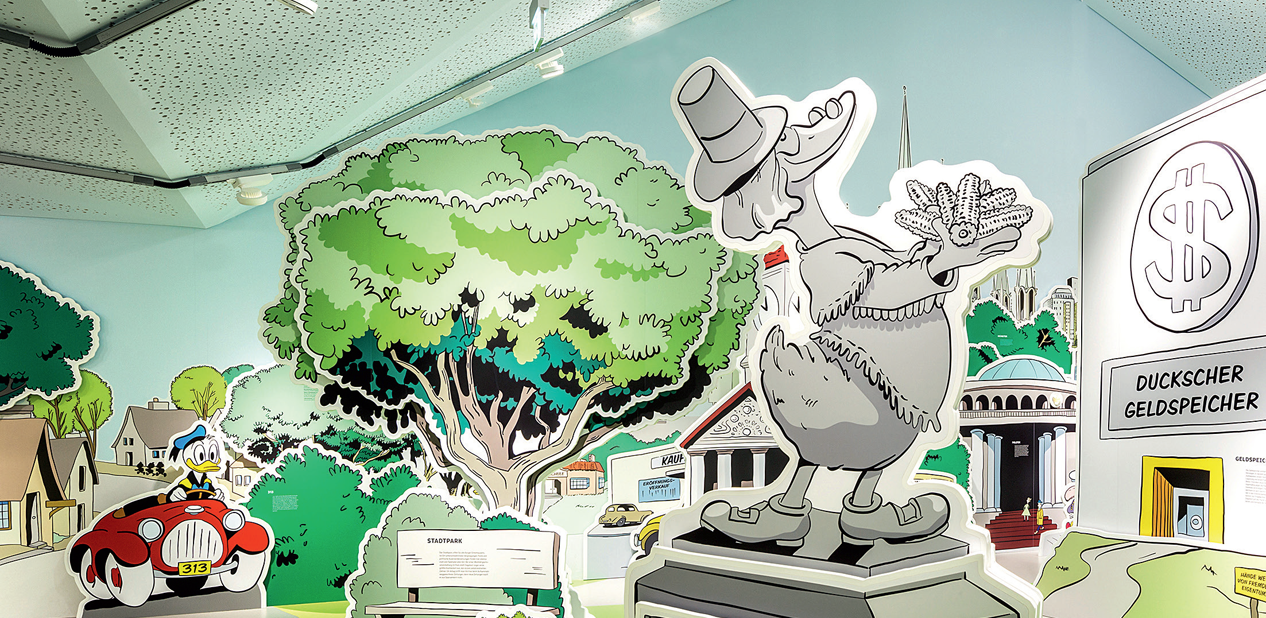For more than 30 years, Erika Fuchs translated the stories from Duckburg from English into German. Her translations influenced the linguistic style of modern German. Scrooge McDuck and Duckburg were still completely unknown in Germany until well into the 1950s. The free approach that Erika Fuchs took to translating the comics and the use of shortened forms of verbs influenced the linguistic style of German by introducing words such as ‘seufz’ (sigh) und ‘ächz’ (groan). For that reason, a museum has been dedicated to her and her work. Since 2015, young and old alike have been able to browse through comics, view original sketches drawn by German comic artists, and even swim in money in the walk-through Duckburg section. It’s great fun that’s not just for all-out comic fans. “Although these comics are viewed as children’s literature, around half of the visitors we have are not accompanied by children. The great thing about the exhibition is that it has something to offer for all age groups. It even has demanding comic literature about the Holocaust,” explains the museum’s director, Dr Alexandra Hentschel. She was also closely involved in the planning and development of the museum.
After entering an architecture competition that was publicised throughout Europe, engineer Dominik Burkard (Dipl.-Ing.) was awarded the project. The task of the competition was to design the entire museum within two months. Burkard’s designs were based on an exhibition concept created by Berlin-based design agency m.o.l.i.t.o.r. GmbH. “The partnership with Pfleiderer only actually began fairly late on in the process – but it was very important,” Burkard explains. The goal of the partnership was to design the public sections of the museum, particularly the entrance area and the shop. It was of course important to use elements that were suitable for their intended use. The high level of footfall in the entrance area meant that durability was a chief concern. Thanks to Pfleiderer’s strategy of pursuing excellence with its decors, the architect for the Erika-Fuchs-Haus found the ideal solution.
composite elements in chapel oak
Pfleiderer’s product range strategy is based in part on the DST system: Decors – Surface textures – core Technology. Combining these individual elements results in countless design options, which provides a tailored solution for every client. Durable medium-density fibreboard (mDF) panels with high-pressure laminate (HPL) were therefore particularly suitable for the museum’s entrance area. High-pressure laminates consist of numerous layers: the core paper, the decor paper and the overlay. This means that they hardly show signs of wear, even in high-use conditions. In terms of visual effect, it was important to Burkard that natural materials were used. The intention was to create a contrasting environment to the design of the exhibition, which has an artifi cial feel to it due to the comic-related content. To do this, he referenced materials typical of the local region of Upper Franconia such as sand and stone because the aim was for the museum’s entrance area to feel inviting and not too rustic.
Burkard ended up choosing the oak decor (R20036 Chapel Oak) as the perfect design for implementing his ideas. The impressive natural-looking, high contrast decor ‘Chapel Oak’ has created an inviting entrance area. The design has small knots and imperfections, which makes it look particularly authentic.
“For the entrance area I chose to use Pfleiderer’s flat bonded elements. After all, one of the requirements was to adhere to fire safety regulations,” the architect explains. When used correctly, the core materials – such as MDF panels – are flame retardant. “This meant that the Chapel Oak HPL surface gave me the perfect combination – it is in keeping with my original design intentions while also being functional,” he continues.
There was a consistently close partnership with Pfleiderer during the creative process. The company provided the architect with a personal point of contact and a wide range of samples. “Although when it came to the artistic side of things, I had the final say,” jokes Burkard. Indeed, in the entrance area, there was also the issue of hiding the electrics behind the decorative aspects. This meant that numerous smaller elements were used, such as counters and sideboards.
In contrast, for the permanent exhibition on the first floor, Burkard chose to use enclosed spaces. The purpose of this was to remove contact with the outside world so that visitors can fully immerse themselves in the comic world. The folded construction of the ceiling is reminiscent of book pages, which accentuates the impression that visitors are inside the pages of the comics.
Although the interior design of the museum has a somewhat natural and subdued character, it creates an atmosphere that has few distractions and that welcomes visitors with tranquillity. This makes it all the more evident that Pfleiderer’s decors can provide the right concept for any specification – after all, subdued sophistication is an art form in its own right.


